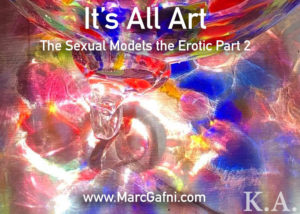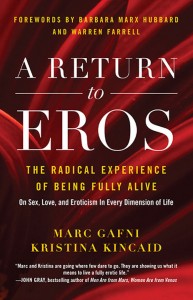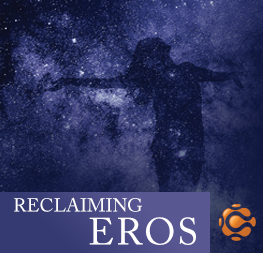It’s All Art
The Sexual Models the Erotic Part 2
This is an excerpt from the book A Return to Eros by Dr. Marc Gafni and Dr. Kristina Kincaid. Here you can read Part 1 of the Series.

Photo by Kristina Amelong, Associate Director of the Outrageous Love Project
Whenever we keep Eros confined to one narrow frame of being while de-eroticizing the rest of the picture, the Shechinah remains in exile. But sex is only one of the places where we exile the erotic. There is a wonderful Balinese saying that goes something like this: “We do not have art–we do everything as beautifully as we can.” When we build ugly cities where beauty is abused and people are depersonalized and then build a beautiful art museum, the Shechinah is in exile. We exile the Eros of beauty to the constricted precincts of formal art.
The same is true of music. Music is not limited to symphonies or rock concerts. We are all musicians, and life is overflowing with music. Remember the Broadway show Stomp? There was no dialogue; it was all music and dance. The catch was that no musical instruments were used. The “instruments” were adapted from the fabric of everyday living: pots, pans, brooms, sinks, faucets, garbage can lids, bottles, bags, newspapers, hands, feet, virtually every part of the body–all of these were used to make music. The implication is stunning: We usually limit art to formal work by people we call artists, just as we limit music to formal instruments and musicians. Formal music and art need to model the erotics of sound and beauty in all of our lives and not just in restricted, narrow provinces. Music and art need to pervade all of living. Every moment is a canvas and is possessed of its own melody. Rumi wisely instructs us:
Let the beauty we love be what we do.
There are hundreds of ways to kneel and kiss the ground.
So too with falling in love. Just as it is nonerotic for art to exist only in a museum, so too it is nonerotic for love to exist only in a small circle of people. When we fall in love with one woman or one man to the exclusion of all other people, the Shechinah is in exile. When you are truly erotically engaged, then through the love of one comes the love of all. For true love partakes in the essential connectivity of being. Unity is not divisible; it is holographic: in every moment of love are all the lovers and all the love in the world.
Too often love is merely a synonym for a radically narrowed sphere of caring. We let only the smallest possible group–sometimes only one person–inside our Holy of Holies. We feel alienated, deceitful, or apathetic about the rest of our lives. The Shechinah is in exile.
Erotic Weddings
In Hebrew Tantra, a wedding is meant to expand and not narrow the circle of Eros. If through the lover each is able to love the world more than before, it is considered a good marriage. If the result of their love is a narrowing in which the world is shut out, then it is not a good marriage.
There is a wonderful mystical teaching that seeks to explain why, according to Hebrew wisdom, one fasts on the day of one’s wedding. The answer given is that the day of the wedding is a personal Yom Kippur for the bride and groom. Yom Kippur, also called the Day of Atonement (at-one-ment), is considered the holiest day of the year. It is a time when all sins are forgiven. It is also an Eros day; it was the only time when the high priest entered the Holy of Holies to perform the mystery rite.
Why, ask the mystics, do the bride and groom require a personal Yom Kippur on the day of their wedding? Because the wedding is about love and Eros. Love and Eros cannot coexist with hate. The only reason most people hate someone is because they themselves did something wrong. Master Nachman of Bratslav says, “Each time you do something wrong, you hate one person.” Whenever we do something wrong, we project our anger at ourselves onto someone else and hate him or her for it. On Yom Kippur, however, all of our sins are forgiven. All wrongs are erased. Therefore, there is nothing left to project outward and no one left to hate. This allows you to truly open your heart to love on the day of your wedding. When the wedding fast is over, all forgiveness made, the wedding begins.
One of the most poignant moments of the Hebrew wedding is the mythic rite of the groom’s placing of a veil over the face of the bride. In doing this, he recognizes that so much of her is still hidden from him, and he commits his life to coming to know her. At this point the community blesses the bride. The officiant invokes the memory of the ancestor Jacob. Jacob is the one who sees Rachel for the first time at the well, falls in love with her instantly, kisses her, and cries. We evoke this story at the wedding because it has some important wisdom to whisper in our ear.
Why does he cry at his first kiss, that moment of ecstasy? They are tears of joy, to be sure. But the mystics add another dimension. They say he cried because at that moment he saw that the Temple in Jerusalem would be destroyed and that the cause of its destruction would be the petty hatred between people. The temple, the symbol of Eros and love, can withstand any attack except that of pettiness and baseless hatred.
What, however, moved the Holy Spirit in Jacob to have that vision and to cry at precisely the moment he loved and kissed Rachel? Because, explain the masters, once you love one person, once you engage one person in true Eros, through that person you love the entire world. Once you are a lover of even one person, you can no longer understand how there could be such pettiness and hatred in the world. You weep at the thought that hatred could destroy the temple of Eros.
So Jacob loved Rachel, and in doing so touched true Eros. In that moment when his lips met hers, Jacob experienced love, longing, intense desire, and connection with the entire world. The kiss aroused his heart and opened it wide to all of being. To be in love is not to be in love with her but to be in love with life by way of her. That is precisely the distinction between ordinary and outrageous love. Had Jacob’s love for Rachel closed his heart to the entire world except for her, the Shechinah would have been in exile. Because Jacob was able to love the world through Rachel, we invoke their story as the model of true love for all generations.
 An excerpt from the book A Return to Eros by Marc Gafni & Kristina Kincaid – one of the key think tank projects of the Center for Integral Wisdom.
An excerpt from the book A Return to Eros by Marc Gafni & Kristina Kincaid – one of the key think tank projects of the Center for Integral Wisdom.
A Return to Eros: On Sex, Love, and Eroticism in Every Dimension of Life, from Drs. Marc Gafni and Kristina Kincaid, reveals the radical secret tenets of relationship between the sexual, the erotic, and the holy. They reveal what Eros actually means and share the ten core qualities of the Erotic, which are modeled by the sexual. These include being on the inside, fullness of presence, yearning, allurement, fantasy, surrender, creativity, pleasure, and more.
A Return to Eros shows why these qualities of the erotic modeled by the sexual are actually the same core qualities of the sacred. The relationship between the sexual and the erotic becomes clear, teaching you how to live an erotically suffused existence charged with purpose, potency and power.
To be an Outrageous Lover–not just in sex but also in all facets of your life–you must listen deeply to the simple yet elegant whisperings of the sexual. This book will forever transform your understanding and experience of love, sex, and Eros.
>>> Buy A Return to Eros Here <<<
Reclaiming Eros
An Online Course with Dr. Marc Gafni
 Imagine being fully expressed with an unstoppable life force that aligned you with the will, the desire, the knowledge and the creative impulse to engage ALL areas of your life full-on; without fear or shame stopping you from moving forward. Imagine the transformative power and positive impact you’d have on your personal relationships and potentially be a major influence in the world.
Imagine being fully expressed with an unstoppable life force that aligned you with the will, the desire, the knowledge and the creative impulse to engage ALL areas of your life full-on; without fear or shame stopping you from moving forward. Imagine the transformative power and positive impact you’d have on your personal relationships and potentially be a major influence in the world.
This is the ideal companion to our think tank book A Return to Eros by Dr. Marc Gafni and Dr. Kristina Kincaid.








